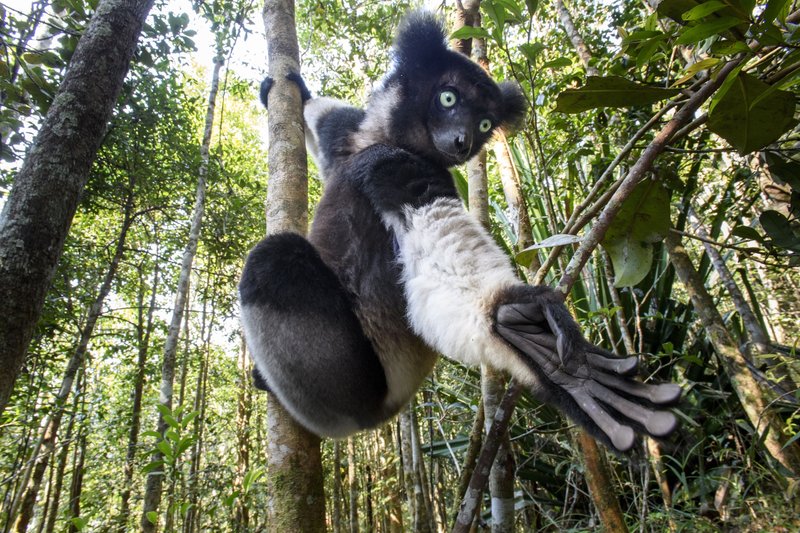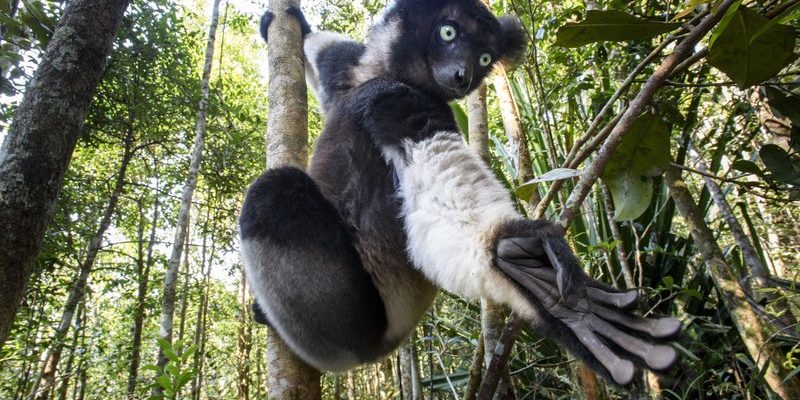
Indris, the largest living lemurs, aren’t just about their striking appearance. They’re packed with behaviors and cognitive abilities that make them unique. Today, we’re diving deep into what makes these little primates tick, exploring their intelligence, behaviors, and the challenges they face in the wild. So, grab a cup of coffee, and let’s unravel the mystery of the indri together!
What Are Indris?
Indris are part of the *Indriidae* family and are native to Madagascar. They’re known for their large size, with adults weighing up to 10 kg (about 22 lbs) and measuring around 70 cm (about 28 inches) long. Their striking black and white fur helps them blend into the leafy canopies of their forest homes.
These primates are also known for their loud, distinctive calls that echo through the forest, often described as a mix between a wail and a song. It’s almost like they’re trying to communicate across vast distances! This vocalization not only strengthens social bonds among groups but also helps them defend their territory.
You might be surprised to know that indris are actually classified as “endangered.” With habitat loss due to deforestation and hunting, their numbers are dwindling. Understanding their cognitive abilities might help in conservation efforts, shedding light on how we can better protect these amazing creatures.
Understanding Their Social Structure
Indris are incredibly social animals that live in small family groups. Typically, these groups consist of one breeding pair and their offspring. The parents are very involved in raising their young, teaching them essential survival skills.
Here’s the thing: their social dynamics are fascinating. Indris communicate extensively with each other, using their voice to maintain group cohesion. This communication isn’t just about staying connected; it also plays a crucial role in their cognitive development. Young indris learn by listening and observing their parents, picking up important social cues and survival tactics along the way.
The bonds within these family units are strong. The indris often engage in playful behaviors, which not only strengthens their relationships but also helps in developing their problem-solving skills. In many ways, their social structure lays the groundwork for their intelligence.
Cognitive Skills and Problem Solving
When it comes to intelligence, indris are quite remarkable. Their ability to navigate complex forest environments shows a high level of spatial awareness and problem-solving skills. Need to leap from one branch to another? They assess the distance, consider the trajectory, and make it happen!
Research has shown that indris can remember the locations of food sources and have a good understanding of their surroundings. This comes in handy when foraging for their favorite food—leaves and fruits. Their diet is quite specific, and knowing where to find these delicacies is crucial for survival.
Indris also showcase creativity in their problem-solving abilities. For example, if they face an obstacle in their path, they might adapt their route rather than simply turning back. This ability to think on their feet highlights not only their intelligence but also their adaptability to changing environments.
Communication: More Than Just Vocalization
Indris are famous for their strong vocalizations, but their communication goes beyond that. They use a range of sounds to express different emotions and needs. When they feel threatened, their calls can echo through the forest with urgency, signaling alarm to others.
Moreover, facial expressions and body language play a crucial role in their interactions. You might catch an indri puffing up or moving closer to a family member, signaling affection or reassurance. This multi-layered communication style enhances their social bonds and helps them coordinate within their groups.
What’s really interesting is how these vocalizations can change based on the situation. For instance, during mating season, males produce specific calls to attract females. This showcases not just their vocal ability but also their instinct to adapt their communication based on context.
Playfulness and Learning
Play is an essential component of an indri’s life. Young indris engage in playful activities that help them develop important skills. Think of it as a toddler playing with building blocks—each tumble and giggle teaches them something new about their environment.
Through play, they learn about social interactions and boundaries. They practice jumping, climbing, and even basic problem-solving in a fun way. You might see them chasing each other around trees or testing their jumping skills on different branches.
This playful nature is tied to their cognitive abilities. The more they experiment, the better they get at navigating their world. This playful learning is crucial for their development and survival in the wild.
Challenges and Conservation
Despite their unique intelligence and capabilities, indris face significant challenges in their habitat. Deforestation, largely driven by agriculture and human expansion, continues to threaten their homes. Without trees, they lose their source of food and shelter.
Additionally, hunting and illegal pet trade further endanger their survival. This brings us back to conservation efforts. Educating local communities about the importance of indris can help foster a culture of protection and respect for these animals.
By highlighting the intelligence and unique behaviors of indris, conservationists aim to inspire action. Protecting their habitat and ensuring they can thrive in the wild is crucial for maintaining biodiversity in Madagascar.
So, how smart is an indri? Honestly, they show remarkable cognitive abilities, from problem-solving and social interaction to creativity and communication. Their intelligence is not just intriguing; it’s essential for their survival in a rapidly changing world.
As we learn more about these magnificent creatures, it becomes clear just how much we have to protect. Indris offer us a peek into the complex lifestyles of lemurs, encouraging us to appreciate and safeguard our natural world. The more we understand their intelligence and behaviors, the better equipped we are to ensure their future. Let’s cherish these furry geniuses and do our part to keep them swinging through the trees for generations to come!

